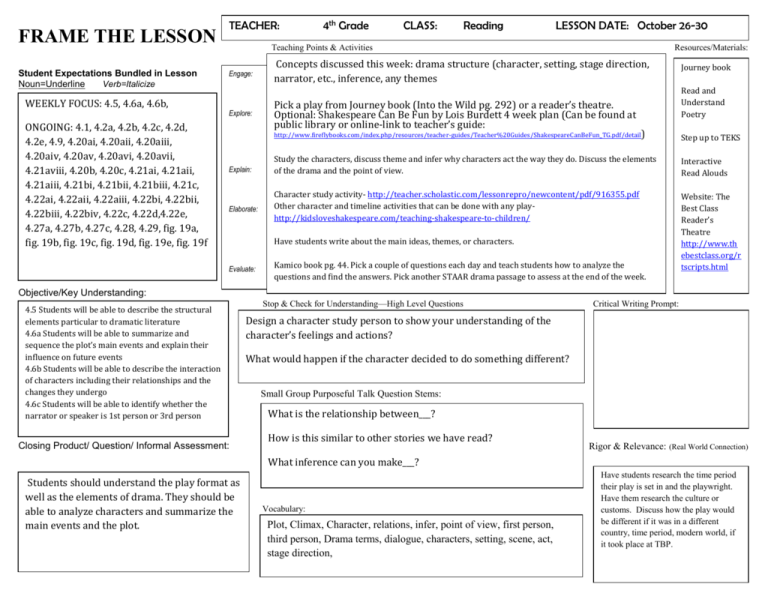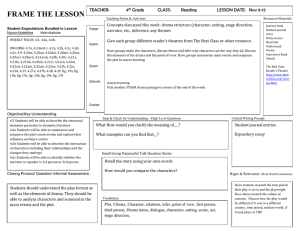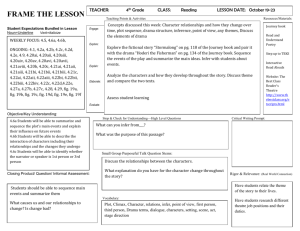4th LF ELAR Oct 26
advertisement

FRAME THE LESSON Student Expectations Bundled in Lesson Noun=Underline Verb=Italicize WEEKLY FOCUS: 4.5, 4.6a, 4.6b, ONGOING: 4.1, 4.2a, 4.2b, 4.2c, 4.2d, 4.2e, 4.9, 4.20ai, 4.20aii, 4.20aiii, 4.20aiv, 4.20av, 4.20avi, 4.20avii, 4.21aviii, 4.20b, 4.20c, 4.21ai, 4.21aii, 4.21aiii, 4.21bi, 4.21bii, 4.21biii, 4.21c, 4.22ai, 4.22aii, 4.22aiii, 4.22bi, 4.22bii, 4.22biii, 4.22biv, 4.22c, 4.22d,4.22e, 4.27a, 4.27b, 4.27c, 4.28, 4.29, fig. 19a, fig. 19b, fig. 19c, fig. 19d, fig. 19e, fig. 19f TEACHER: 4th Grade CLASS: Reading LESSON DATE: October 26-30 Teaching Points & Activities Resources/Materials: Engage: Concepts discussed this week: drama structure (character, setting, stage direction, narrator, etc., inference, any themes Explore: Pick a play from Journey book (Into the Wild pg. 292) or a reader’s theatre. Optional: Shakespeare Can Be Fun by Lois Burdett 4 week plan (Can be found at public library or online-link to teacher’s guide: Explain: Elaborate: Read and Understand Poetry http://www.fireflybooks.com/index.php/resources/teacher-guides/Teacher%20Guides/ShakespeareCanBeFun_TG.pdf/detail) Step up to TEKS Study the characters, discuss theme and infer why characters act the way they do. Discuss the elements of the drama and the point of view. Interactive Read Alouds Character study activity- http://teacher.scholastic.com/lessonrepro/newcontent/pdf/916355.pdf Other character and timeline activities that can be done with any playhttp://kidsloveshakespeare.com/teaching-shakespeare-to-children/ Website: The Best Class Reader’s Theatre http://www.th ebestclass.org/r tscripts.html Have students write about the main ideas, themes, or characters. Evaluate: Journey book Kamico book pg. 44. Pick a couple of questions each day and teach students how to analyze the questions and find the answers. Pick another STAAR drama passage to assess at the end of the week. Objective/Key Understanding: 4.5 Students will be able to describe the structural elements particular to dramatic literature 4.6a Students will be able to summarize and sequence the plot’s main events and explain their influence on future events 4.6b Students will be able to describe the interaction of characters including their relationships and the changes they undergo 4.6c Students will be able to identify whether the narrator or speaker is 1st person or 3rd person Closing Product/ Question/ Informal Assessment: Stop & Check for Understanding—High Level Questions Critical Writing Prompt: Design a character study person to show your understanding of the character’s feelings and actions? What would happen if the character decided to do something different? Small Group Purposeful Talk Question Stems: What is the relationship between___? How is this similar to other stories we have read? Rigor & Relevance: (Real World Connection) What inference can you make___? Students should understand the play format as well as the elements of drama. They should be able to analyze characters and summarize the main events and the plot. Vocabulary: Plot, Climax, Character, relations, infer, point of view, first person, third person, Drama terms, dialogue, characters, setting, scene, act, stage direction, Have students research the time period their play is set in and the playwright. Have them research the culture or customs. Discuss how the play would be different if it was in a different country, time period, modern world, if it took place at TBP. FRAME THE LESSON Student Expectations Bundled in Lesson Noun=Underline Verb=Italicize TEACHER: Engage: WEEKLY FOCUS: 4.18 Explore: ONGOING: 4.1, 4.2a, 4.2b, 4.2c, 4.2d, 4.2e, 4.9, 4.20ai, 4.20aii, 4.20aiii, 4.20aiv, 4.20av, 4.20avi, 4.20avii, 4.21aviii, 4.20b, 4.20c, 4.21ai, 4.21aii, 4.21aiii, 4.21bi, 4.21bii, 4.21biii, 4.21c, 4.22ai, 4.22aii, 4.22aiii, 4.22bi, 4.22bii, 4.22biii, 4.22biv, 4.22c, 4.22d,4.22e, 4.27a, 4.27b, 4.27c, 4.28, 4.29, fig. 19a, fig. 19b, fig. 19c, fig. 19d, fig. 19e, fig. 19f 4th Grade Teaching Points & Activities Explain: CLASS: Writing LESSON DATE: October 19-23 Resources/Materials: Every day: student journal entry Grammar mini lesson topics for this week: Spell words with advanced orthographic patterns, punctuation, quotation marks, plural rules(endings in f), irregular verbs, double consonants in middle of words Student journal entry Using Expository Comprehension Guide from Empowering Writers, cover these topics this week Activity lesson plans are in the book: - Golden Bricks, introduction pgs. 241-251 - Model and practice detail generating questions pgs. 189-235 Step up to TEKS Write source Elaborate: Evaluate: Objective/Key Understanding: 4.18 Expository/Procedural texts. Students will be able to create brief compositions that: 4.18A.i. establishes a central idea in a topic sentence 4.18A.ii. includes supporting sentences with simple facts, details, and explanations, 4.18A.iii.contains a concluding statement Critical Writing Prompt: Stop & Check for Understanding- High Level Questions What is the relationship between__? How is this similar to___? Students will write using golden bricks and detail generating questions Small Group Purposeful Talk Question Stems: How would you elaborate on ____? Closing Product/ Question/ Informal Assessment: Students can create elaborative detail about a topic identify and use golden bricks Rigor & Relevance: (Real World Connection) Build student background knowledge on topics and create experiences for them to draw upon in their writing Vocabulary Expository, pyramid, informational, annotate, summarize, irrelevant details, compare, main idea, strong vs. weak, detail generating questions, golden bricks, leads, topic sentences, introduction, conclusion,






